When it comes to effectively applying pesticides, having the right backpack sprayer can make all the difference. You'll find that the top five models in 2024—D.B. Smith FIELD KING, Chapin, RealWork, Field King Max, and Chapin 61800—each offer distinct advantages tailored to your needs. From ease of use to adjustable pressure settings, these sprayers stand out in a crowded market. But which one truly fits your requirements? Let's explore the features that set these models apart and help you make an informed decision.
D.B. Smith FIELD KING 190328 Backpack Sprayer, 4 Gallon,
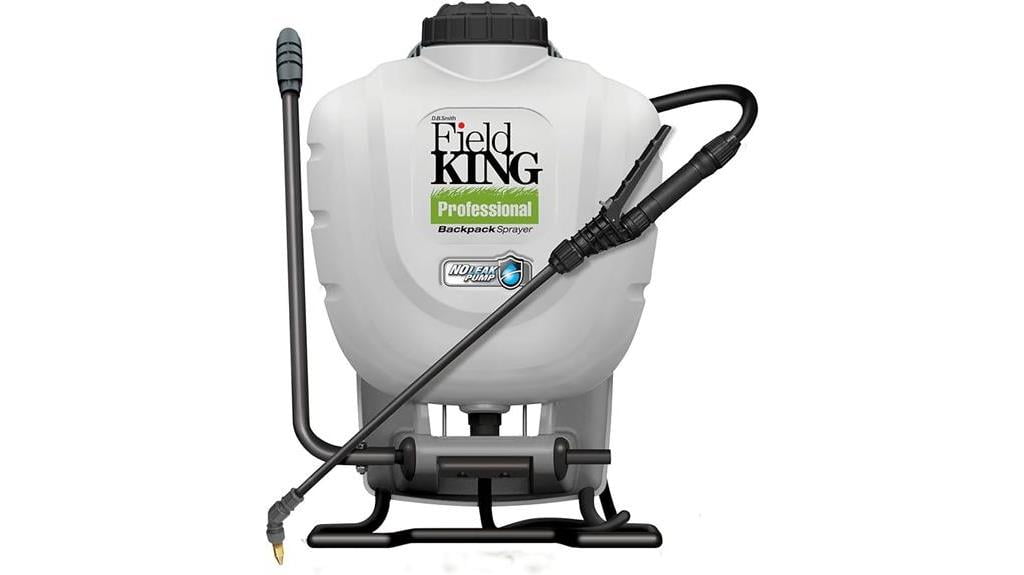
If you're looking for a reliable and efficient way to apply pesticides, the D.B. Smith FIELD KING 190328 Backpack Sprayer is an excellent choice. With a 4-gallon tank and a maximum pressure of 150 PSI, it easily tackles hard-to-reach areas. Weighing just 12.8 pounds, it's comfortable to carry, thanks to the adjustable padded straps and waist belt. The internal no-leak design means I never worry about chemicals dripping down my back. I appreciate the six nozzle options, which allow me to switch between different spray patterns for various tasks. Plus, the easy-access pump lets me change seals without tools, making maintenance a breeze. Overall, this sprayer combines efficiency and durability, making it a standout in the market.
Best For: Homeowners and garden enthusiasts looking for a reliable and efficient backpack sprayer for applying pesticides and fertilizers.
Pros:
- Durable construction with high-quality materials ensures longevity and reliability.
- Multiple nozzle options provide versatility for various spraying tasks and patterns.
- Comfortable design with adjustable padded straps makes it easy to carry for extended periods.
Cons:
- Weight may be a concern for some users during prolonged use despite being reasonably lightweight.
- Manual operation requires physical effort compared to electric sprayers.
- Initial setup and maintenance may take some time for those unfamiliar with backpack sprayers.
Chapin 60114 4-Gallon Backpack Sprayer
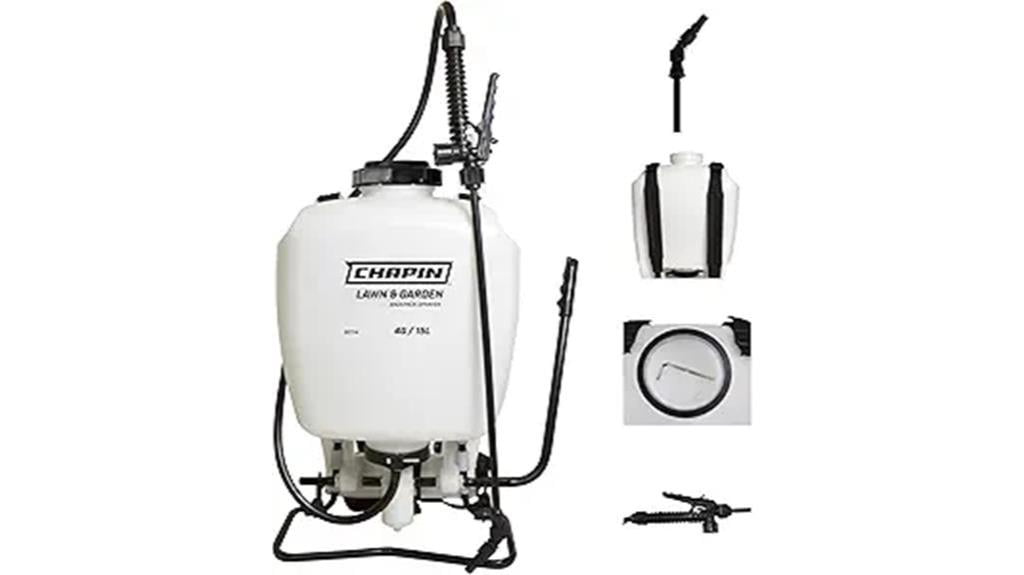
The Chapin 60114 4-Gallon Backpack Sprayer stands out as an excellent choice for both homeowners and professional landscapers who need a reliable and efficient tool for applying pesticides and fertilizers. I love its durable 4-gallon translucent tank, allowing me to easily monitor the liquid level. The 20-inch extension wand helps me reach tricky spots, and the padded shoulder straps provide comfort during long tasks. With a maximum pressure of 60 PSI and a versatile adjustable nozzle, I can customize my spray patterns to suit any job. While some users mention assembly issues, I found that following the instructions carefully made a difference. Overall, it's a solid sprayer that delivers effective performance with proper maintenance.
Best For: Homeowners and professional landscapers seeking a reliable and efficient backpack sprayer for pesticides and fertilizers.
Pros:
- Durable 4-gallon translucent tank for easy liquid level monitoring.
- Comfortable padded shoulder straps and adjustable waist strap for extended use.
- Versatile adjustable nozzle and 20-inch extension wand for reaching difficult areas.
Cons:
- Some users report difficulties with assembly instructions.
- Mixed feedback on shoulder strap comfort under heavy loads.
- Occasional complaints about pump reliability.
RealWork 4-Gallon Backpack Sprayer
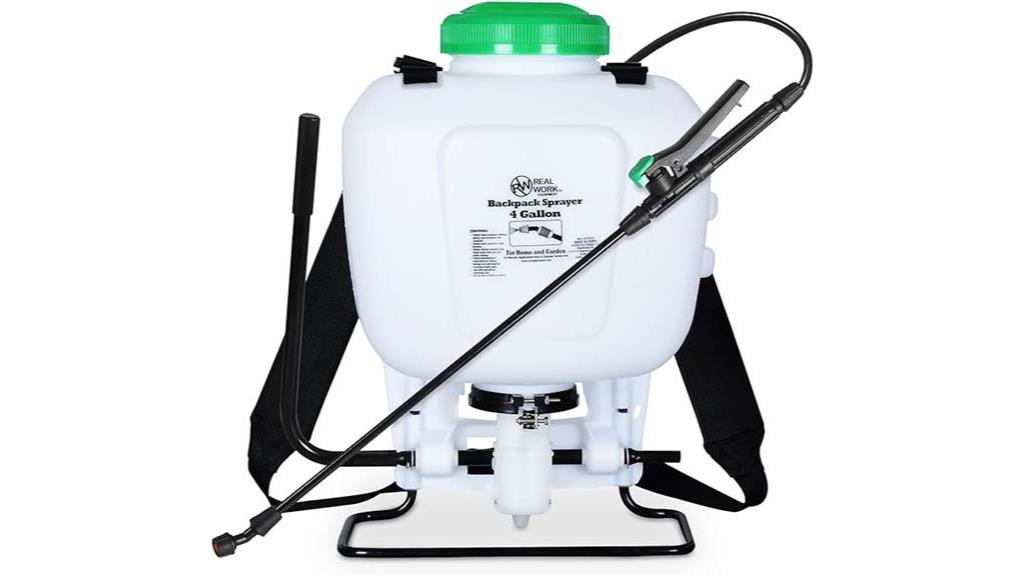
For those who value both comfort and efficiency in their gardening tasks, the RealWork 4-Gallon Backpack Sprayer stands out as an excellent choice. Weighing only 8 pounds, it's designed with padded shoulder straps for comfort during extended use. The translucent white tank allows me to easily monitor fluid levels, while the funnel top makes filling a breeze. I appreciate the high-efficiency pump and chemical-resistant seals, which guarantee reliable operation. Plus, the locking trigger enables continuous spray, and the adjustable nozzles cater to various needs. Whether I'm tackling pest control or watering my garden, this sprayer's versatility shines. Though some users reported minor issues, customer support is responsive, making it a solid investment for gardeners at any level.
Best For: Gardeners seeking a versatile and comfortable sprayer for both indoor and outdoor tasks.
Pros:
- Lightweight design (only 8 pounds) makes it easy to carry for extended periods.
- Adjustable nozzles provide flexibility for various spraying needs, from pest control to watering.
- Translucent tank allows for easy monitoring of fluid levels.
Cons:
- Some users have reported missing components upon arrival.
- Leaks have been noted by a few customers, affecting the usability.
- Suggestions for improvement include the trigger lock design and the addition of a waist strap for better support.
Field King Max Backpack Sprayer for Professionals
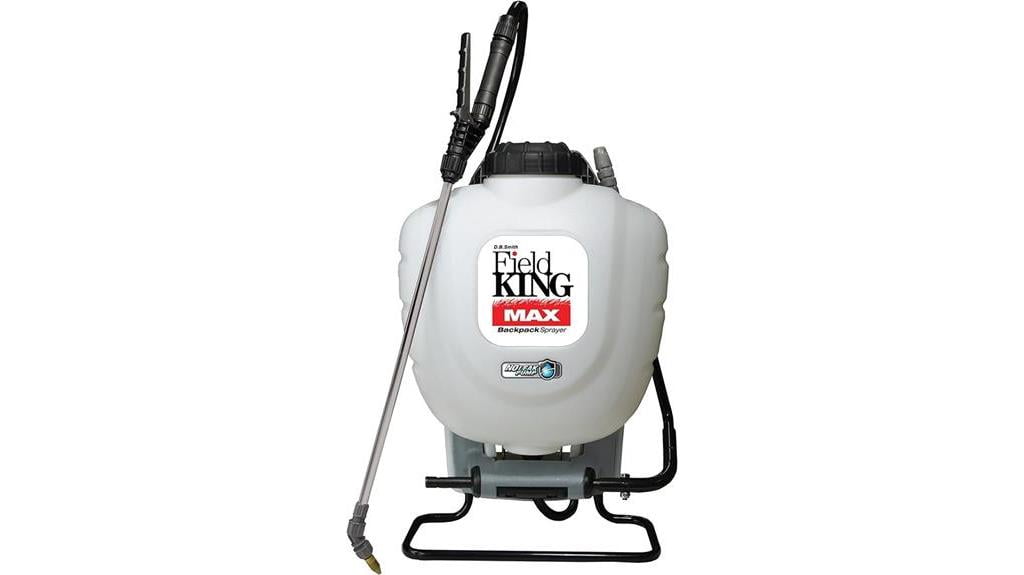
Designed specifically for professionals, the Field King Max Backpack Sprayer stands out with its innovative no leak pump design, ensuring you won't waste precious chemicals while working. With a capacity of 4 gallons and a powerful spray capability of up to 150 PSI, this sprayer delivers consistent performance, especially for herbicides at 25 PSI. The durable stainless steel wand and adjustable nozzles cater to various spraying needs, providing exceptional coverage.
I appreciate the comfort of the deluxe harness and the ease of accessing the pump for quick maintenance. Although it weighs 12.8 pounds, the design allows for left- or right-handed use, making it versatile. Overall, it's a top choice for anyone needing reliability and efficiency in their spraying tasks.
Best For: Professionals seeking a reliable and efficient backpack sprayer for herbicide application and larger areas.
Pros:
- Durable construction with stainless steel and brass components ensures longevity.
- Versatile nozzle options allow for tailored spraying solutions for different tasks.
- Comfortable deluxe harness design reduces fatigue during extended use.
Cons:
- Weighing 12.8 pounds, it may be cumbersome for some users during prolonged operation.
- Constant pumping may be challenging for users over long durations.
- Requires proper adjustment and technique for optimal comfort and performance.
Chapin 61800 4-Gallon Professional Backpack Sprayer
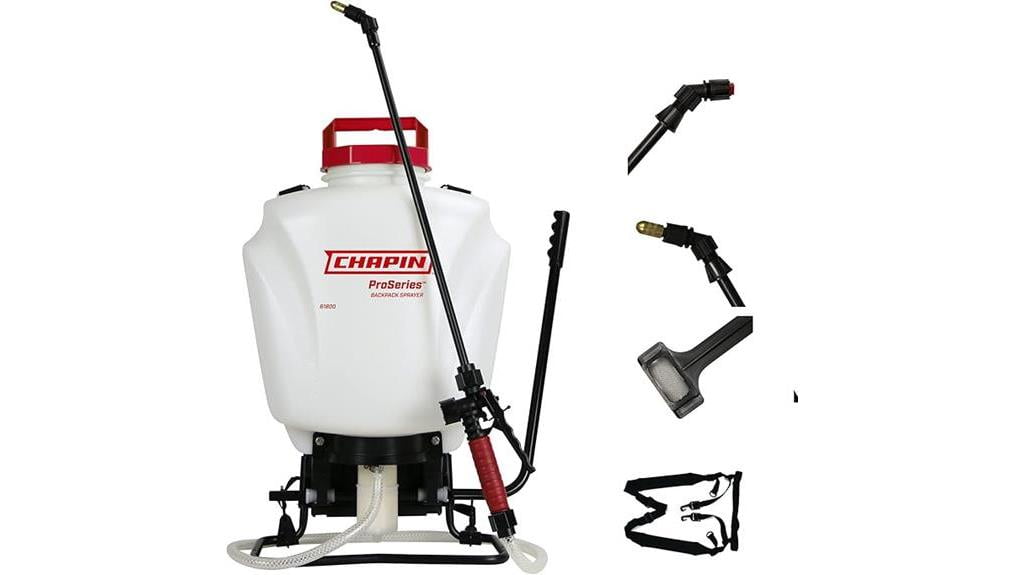
With its durable 4-gallon translucent poly tank, the Chapin 61800 Professional Backpack Sprayer is perfect for anyone who needs to keep a close eye on their pesticide levels while working efficiently. Weighing just 10 pounds, it features adjustable padded shoulder straps and a 48-inch reinforced hose for comfort and ease of use. The sprayer includes three nozzles, allowing for versatile applications in pest control, watering, and weed management. I appreciate the cushion grip shut-off and the filter cap that catches debris, ensuring smooth operation. Plus, its 2-year limited warranty offers peace of mind. However, be cautious with corrosive solutions, as they can affect the seals. Overall, this sprayer's design and performance make it a reliable choice for any gardener.
Best For: The Chapin 61800 4-Gallon Professional Backpack Sprayer is best for gardeners and landscapers who require a reliable, efficient tool for pest control, watering, and weed management.
Pros:
- Durable translucent poly tank allows for easy visibility of capacity.
- Adjustable padded shoulder straps and a cushioned grip ensure comfort during use.
- Comes with three versatile nozzles for various spraying applications.
Cons:
- Some users report issues with the durability of the straps.
- Potential problems with lid fit and leaks have been noted.
- Caution is required when using corrosive solutions, as they can damage seals.
Factors to Consider When Choosing Backpack Sprayers for Pesticides
When choosing a backpack sprayer for pesticides, you should consider several key factors. Look at tank capacity options, pressure performance levels, and how the weight affects your comfort during use. Additionally, nozzle versatility and the durability of materials play a significant role in ensuring you get the best results.
Tank Capacity Options
Choosing the right tank capacity for your backpack sprayer is essential for achieving efficiency in pesticide application. Backpack sprayers generally come in various sizes, with 4-gallon options being popular for both residential and professional use. This capacity strikes a balance between weight and volume, allowing you to spray longer without frequent refills.
If you opt for a larger tank, like a 4-gallon model, you'll enjoy extended spraying sessions, reducing interruptions. However, keep in mind that larger tanks can be heavier, which might be challenging if you're not accustomed to carrying extra weight for long periods. On the other hand, smaller tank capacities may be lighter and easier to maneuver, but they require more frequent refills, which can slow you down during larger applications.
When choosing a tank capacity, consider the size of the area you'll be treating and how long you plan to spray. Your physical strength and endurance also play a significant role; make sure you choose a capacity that you can comfortably handle throughout your task. Balancing these factors will help you maximize efficiency and effectiveness in your pesticide application.
Pressure Performance Levels
Pressure performance levels play an essential role in the effectiveness of your backpack sprayer for pesticide application. When choosing a sprayer, you'll notice that maximum pressure levels can vary greatly. Some models reach up to 150 PSI, which is ideal for reaching hard-to-access areas and achieving consistent spray patterns. On the other hand, sprayers with a maximum of 60 PSI might be suitable for lighter tasks but often fall short in covering larger or denser areas effectively.
Higher pressure capabilities are particularly beneficial for herbicide applications, which typically require a continuous pressure of around 25 PSI for best results. Additionally, the internal pump design is important; features like internal no-leak pumps can prevent annoying chemical drips, enhancing your overall experience.
As you evaluate your options, keep in mind that pressure performance is essential for achieving the desired spray distance and coverage. Different nozzle types and sizes can also impact how efficiently you distribute pesticides. By focusing on these factors, you can guarantee that your backpack sprayer meets your specific needs for effective pesticide application.
Weight and Comfort
Finding the right balance between weight and comfort is essential for anyone using a backpack sprayer for pesticides. Most backpack sprayers weigh between 8 and 12.8 pounds, and this weight can considerably affect your fatigue levels during prolonged spraying sessions. Opting for a lighter model, ideally around 8 pounds, can make a noticeable difference, especially if you're not particularly strong.
Look for adjustable padded shoulder straps and waist belts, as these features help distribute weight evenly across your body, enhancing comfort during extended use. Some models come equipped with deluxe harnesses that include a full back pad and chest cinch strap, providing improved support and reducing strain on your back.
Additionally, consider how the sprayer is balanced. Models that allow for left- or right-handed use and have adjustable pump handles can greatly enhance your experience. A well-balanced sprayer not only minimizes discomfort but also allows for smoother and more efficient maneuverability, making your spraying tasks easier. By prioritizing weight and comfort, you'll guarantee that your pesticide application is not only effective but also less taxing on your body.
Nozzle Versatility
Nozzle versatility plays an essential role in the effectiveness of backpack sprayers for pesticides. When you choose a sprayer, consider how well it allows you to adjust spray patterns and flow rates for different tasks, such as pest control, watering, or weed management. Multiple nozzle options, including adjustable brass nozzles and various fan patterns, provide efficient coverage for both large and hard-to-reach areas.
Look for sprayers equipped with specialized nozzles, such as foaming or jet stream options. These can enhance the effectiveness of your chemical applications, ensuring better adherence to surfaces or targeted areas. The ability to switch nozzles easily can save you time and eliminate the need for multiple sprayers, making it more convenient to adapt to varying tasks.
Additionally, consider compatibility with other nozzle brands, like TeeJet, to further expand your spraying capabilities. This feature allows for customized solutions based on your specific pesticide needs. By focusing on nozzle versatility, you can markedly improve your spraying efficiency and effectiveness, ensuring peak results in your pest management efforts.
Durability and Materials
When you're selecting a backpack sprayer for pesticides, the durability and materials used in its construction should be at the forefront of your decision-making process. Look for models made from durable materials like stainless steel, brass, or high-density polyethylene (HDPE). These materials enhance longevity and resist chemical degradation, ensuring your sprayer can withstand the rigors of heavy use.
A robust tank design is also important. Opt for sprayers with a translucent poly construction that allows you to easily monitor liquid levels while ensuring the tank can handle pressure without leaking. Additionally, check for chemical-resistant seals, as these components are essential for maintaining integrity when using various fertilizers, pesticides, and herbicides.
Don't overlook the weight of the sprayer. Lighter models often provide better comfort during extended use, especially if they're made with high-quality yet lightweight materials. Finally, evaluate the overall build quality, including the strength of the straps and sturdiness of the wand. These factors greatly influence the sprayer's durability and your experience during operation, making them fundamental considerations for effective pest management.
Ease of Maintenance
Maintaining your backpack sprayer shouldn't feel like a chore, so choosing a model designed for easy upkeep can save you time and hassle. Start by looking for sprayers with easy access pumps that allow for quick seal changes without tools. This feature considerably reduces maintenance time compared to other models.
Additionally, consider sprayers that include removable in-line filters. These filters help minimize clogging and make the clean-up process after use a breeze. Wide mouth openings are another crucial feature, as they facilitate easy filling and cleaning, making maintenance straightforward.
Chemical-resistant seals and materials are also essential. They prevent leaks and can extend the lifespan of your equipment, giving you more value for your investment. Finally, opt for sprayers that come with thorough maintenance guides or robust customer support. This guarantees you have the necessary resources for proper care and troubleshooting.
Pump Design Efficiency
Choosing the right pump design is vital for maximizing the efficiency of your backpack sprayer. The pump's efficiency directly affects the maximum pressure you can achieve, with some models delivering up to 150 PSI. This level of pressure is essential for effective pesticide application, especially in hard-to-reach areas.
Look for internal no leak pump designs. These prevent chemicals from dripping down your back, enhancing both safety and comfort during use. You'll also want to evaluate how easy it is to access the pump for maintenance. Models that allow tool-free seal changes in under five minutes can greatly reduce downtime, keeping your spraying tasks on schedule.
A high-capacity internal piston pump is another must-have feature. It helps maintain consistent pressure and spray patterns, leading to more efficient pesticide use and reduced chemical waste. Additionally, sprayers with adjustable shut-offs and multiple nozzle options provide you the versatility needed for different pesticides and treatment areas. This adaptability allows you to tailor your spraying approach, ensuring you get the results you need without overusing products.
Strap Adjustability and Support
Finding a backpack sprayer that fits comfortably can make a tremendous difference during long spraying sessions. Look for sprayers with adjustable padded shoulder straps and waist belts to boost your comfort and support. This is vital, especially when you're carrying a full tank for extended periods.
Consider models that include chest cinch straps, as they help distribute weight evenly across your body, reducing fatigue. It's important to guarantee the straps are easily adjustable, allowing you to customize the fit based on your body type and personal preference.
Opt for sprayers featuring a deluxe harness or a full back pad, as these elements offer additional support and comfort. They can greatly improve your experience while you work.
Also, pay attention to the positioning of the pump handle. Some designs cater to both left- and right-handed users, which contributes to overall comfort during operation. By prioritizing strap adjustability and support, you'll enhance your efficiency in the field and possibly reduce any strains or injuries that might come from improper fit. Choose wisely, and enjoy your spraying tasks!
Frequently Asked Questions
How Do I Clean My Backpack Sprayer After Use?
To clean your backpack sprayer after use, start by emptying any remaining solution. Rinse the tank with clean water, filling it halfway, then swish it around and pour it out. Repeat this process two to three times. Next, remove and rinse the nozzle and hoses to eliminate any residue. Finally, let all parts dry completely before storing. Regular cleaning guarantees your sprayer lasts longer and performs effectively for future applications.
Can Backpack Sprayers Be Used for Fertilizers Too?
Backpack sprayers can be a fantastic fit for fertilizers too. They're versatile tools that help you efficiently distribute nutrients. When using a sprayer for fertilizers, just make sure you clean it thoroughly after each use to avoid clogs and contamination. Mixing and matching fertilizers is fun, but always check your sprayer's compatibility. With the right care, you'll keep your garden thriving and your sprayer singing! Happy spraying!
What Safety Gear Should I Wear While Spraying?
When you're spraying, it's essential to prioritize safety. You should wear protective eyewear to shield your eyes from chemicals, a mask or respirator to filter out harmful vapors, and gloves to keep your skin safe. Long sleeves and pants can help protect against any splashes or drips. Don't forget sturdy boots to prevent slipping and protect your feet. By wearing the right gear, you'll minimize health risks while working effectively.
How Long Do Backpack Sprayers Typically Last?
Backpack sprayers can feel like they've been forged in the fires of durability, often lasting anywhere from 5 to 10 years with proper care. You'll want to routinely check and maintain your sprayer to guarantee it stands the test of time. By cleaning the tank and replacing worn parts, you're maximizing its lifespan. So, treat your sprayer well, and it'll serve you faithfully through countless spraying adventures.
Are Electric Backpack Sprayers More Effective Than Manual Ones?
When considering if electric backpack sprayers are more effective than manual ones, it really depends on your needs. Electric sprayers often provide consistent pressure and require less physical effort, making them ideal for larger areas. However, manual sprayers can be more portable and easier to maintain. If you're tackling small jobs or need flexibility, a manual sprayer might suit you better. Ultimately, it's about finding the right tool for your specific tasks.
Wrapping Up
Choosing the right backpack sprayer can feel overwhelming, but it's all about finding the perfect match for your needs. Whether you're tackling a small garden or a larger property, each model offers something unique. Coincidentally, the sprayer you select might just enhance not only your efficiency but also your enjoyment of the task at hand. So, take your time, consider the features that matter most to you, and you'll find the sprayer that feels like it was made just for you.
